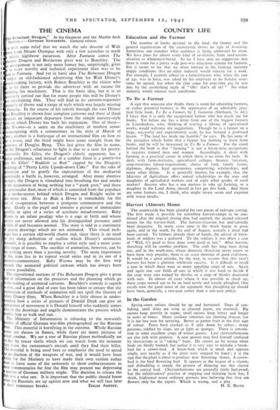THE CINEMA e Reluctant Dragon," At the Gaumont and the
Marble Arch Pavilion.--German Newsreels. General release.
is with some relief that we watch the safe descent of Walt ney from Mount Olympus with only a few scratches to mark recent highbrow excursion. After Fantasia comes The luctant Dragon and Beethoven gives way to Benchley. The arrangement is not only more homey but, surprisingly, gives to more novelty and technical experiment than was to be
d in Fantasia. And yet in basic idea The Reluctant Dragon simply an old-fashioned advertising film for Walt Disney's oon-making factory, with Robert Benchley as the visitor who to be there to provide the advertiser with an ,excuse for lining his machinery. That is the basic idea, but it is so micusly carried out that for many people this will be Disney's
t entertaining film. They will find in its cartoon-sequences turity of theme and a range of style which was largely missing Fantasia. In the course of his travels through the vast Disney t Benchley is shown four complete cartoons and three of them resent an important departure from the simple nursery-style on which Disney has built his reputation. One of them— by Weems—is a satire on the machinery of modern sensa- n-mongering with a commentary in the style of March of ne; another is a burlesque of an instructional film on how to e a horse, and the third might have come straight from the noire of Douglas Byng. This last gives the film its name, the Dragon's reluctance to fight is due to a taste for poetry. rtunately Six Giles, the Dragon's elderly opponent, has a ilar preference, and instead of a combat there is a poetry-tea
• h Sir Giles' " Raddish so Red" capped by the Dragon's dering of "Pretty Little Upside-down Cake." For the sake of nvention and to gratify the expectations of the mediaeval untryside a battle is, however, arranged. After many abortive tempts, the Dragon is stimulated into breathing fire and smoke the accusation of being nothing but a "punk poet," and there a spectacular-duel, most of which is concealed from the populace a smoke-screen behind which Dragon and Knight waltz or ke more tea. How to Ride a Horse is remarkable for the ek of co-operation between a pompous commentator and the rse. Goofy is the pupil and remains a picture of immaculate entility in spite of a series of acrobatic misadventures. Baby eems is an infant prodigy who is a sage at birth and whose ems are never allowed into his distinguished presence until °falls ill and becomes normal. The story is told in a continuity crayon drawings which are not animated. This visual tech- que has a certain old-world charm and, since there is no need
r the sharp definition of outline which Disney's animation emands, it is possible to employ a softer style and a more com- ae range of tones. The sacrifice of animation, however, can be it nothing more than a passing novelty. The main importance f this item lies in its topical social satire and in its use of a arrative-commentary. Baby Weems may be the first step wards the animated political cartoon which has always been screen possibility.
The expositional sections of The Reluctant Dragon give a great eal of information on the .processes and the planning which go the making of animated cartoons. Benchley's comedy is superb s ever, and a great deal of care has been taken to ensure that the xPlanation of methods of animation will not spoil the illusion of ture Disney films. When Benchley is a little obtuse in under- tanding how a series of pictures of Donald Duck can give an ppearance of movement it is Donald himself who suddenly comes we in the drawings and angrily demonstrates the process which ables him to walk and run.
The Ministry of Information is releasing to the newsreels ches of official German war-film ,photographed on the Russian ant This material is horrifying in -the extreme. Whole Russian owns are shown in -flames, while there- are many pictures of aual combat. We see a row of Russian planes methodically set fire by tracer shells which we can watch from the moment ey leave the cameraman's aircraft until they find their billet.
e material is being used here to emphasise the need to speed P production of the weapons of war, and it would have been tter for the Ministry to have made their own version rather an to leave some -of the newsreels to show embarrassment in or commentaries for -fear the film may present too depressing picture of German military might. The decision to release -the lin was a wise one. It is important that the public should know hat the Russians are up against now and What we will face later their resistance breaks. EDGAR ArrsrEY.


























 Previous page
Previous page